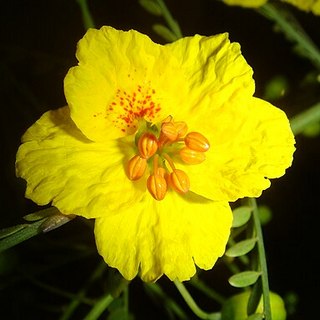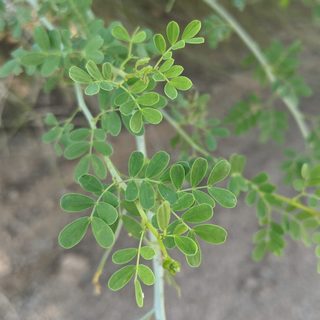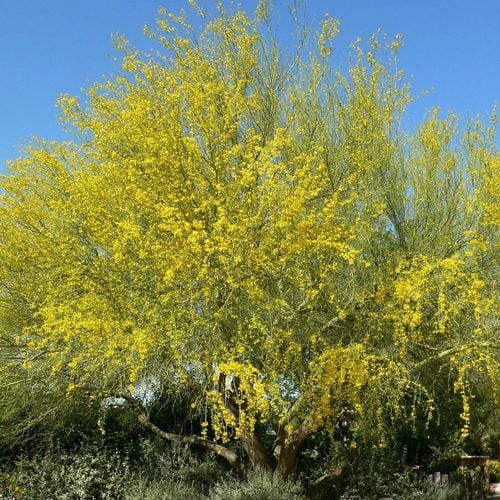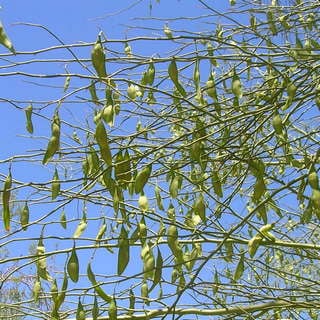Blue palo verde is a fast-growing, drought-tolerant tree with green bark. You know that spring has arrived when these trees put on their display of sunny yellow flowers. Here’s everything you need to know about growing this Sonoran Desert native.

Blue palo verde (Parkinsonia florida) is a medium size tree with green bark and small blue-green leaves. When in bloom, these trees are adorned with bright yellow flowers that have obvious orange stamens and red-orange dots on just one petal. Flowers are followed by edible pods.
Blue palo verde is the first palo verde species to bloom in the spring. This tree’s explosion of yellow flowers is an unmissable sign that spring has arrived in the desert.
Blue palo verde is an important Sonoran Desert native that evolved to thrive in harsh conditions. In its native habitat, it usually grows along desert washes, where it can survive on as little as 3 to 12 inches of annual rainfall.
The name palo verde means “green stick”. The green stems and branches of palo verdes are covered with photosynthetic bark. But unlike other palo verdes, its trunk eventually turns brown with age.
Blue palo verde is a great tree for attracting wildlife — butterflies, bees, and other insect pollinators feed on the nectar. It is a larval host for many species of moths. Birds eat the seeds and use the tree for shelter.
Things I Like About This Plant
- Eye-catching yellow flowers
- Unusual green bark
- Low water use, low maintenance
- Supports wildlife

Things to Watch Out For
Some people don’t like the mess these trees make when they lose their flowers in the spring, while others marvel at the beautiful carpet of yellow. So know where you stand before planting. Abundant flowers make this a poor choice to grow near a pool or anywhere else you don’t want litter.
Branches have thorns, albeit not particularly nasty ones.
Blue palo verde loses its leaves in drought or cold, and is normally leafless some of the year.

Blue palo verdes naturally have multiple trunks and look their best when allowed to sprawl, so this is not the right tree if you’re looking for a single-trunk “lollipop” tree.

Spring allergies are often blamed on palo verdes,
but they are not a major culprit. Learn why here.
Optimal Growing Conditions
If you’re thinking of adding a blue palo verde to your garden, you need to find a suitable place that will keep your plant healthy and looking good… while minimizing maintenance for you.
Here are the key factors to keep in mind.
Temperature
Blue palo verde should be grown in USDA Hardiness Zones 8 – 10. As a Sonoran Desert native, it is at home in extreme heat. It will survive temperature dips as low as 10℉, but may suffer damage below 20℉.
Sun Exposure
Blue palo verde thrives in full sun and tolerates the reflected sun off of buildings or walls.
Size and Growth Rate
Blue palo verdes grow fast and typically reach a size of 25 feet tall and wide. They normally bloom in March or April, and have a reasonably long bloom period of 3 to 5 weeks. Occasionally, they bloom again in late summer to early fall.
Soil
Blue palo verde grows well in any kind of native soil, provided it’s well-draining.
Don’t put organic mulch under the canopy of palo verdes, mulch with gravel or decomposed granite instead.
Pests & Diseases
Like other palo verdes, the blue species is prone to witches’ broom, desert mistletoe, and the palo verde root borer beetle (Derobrachus hovorei).
Palo verde root borers are often blamed for damaging or killing palo verdes, but they are not considered a threat to healthy trees. The beetles spend no more than a month of their life cycle above ground and do not eat. Their grubs, which live underground for 2 to 4 years, feed mainly on the dead wood of older or stressed trees.
Blue Palo Verde:
The Essentials
| Common Name | Blue palo verde |
| Scientific Name | Parkinsonia florida |
| Origin | Sonoran Desert |
| Plant Type | Semi-deciduous tree |
| USDA Zones | Zones 8 – 10 |
| Cold Hardiness | To 20℉ |
| Flower Color | Yellow |
| Flower Season | Spring |
| Mature Size | 25’ high x 25’ wide |
| Growth Rate | Fast |
| Sun Tolerance | Full, reflected sun |
| Water Needs | Low |
| Pests & Diseases | Root borers, desert mistletoe, witches’ broom |
| Garden Friendly | Edible flowers, seeds |
| Cautions | Thorns |
| Wildlife | Attracts butterflies, moths, bees |
How to Plant
The rule of thumb when planting any tree in the desert is to dig a hole three times as wide as the root ball but no deeper. Amending the soil is not recommended. Counterintuitively, backfilling with the same native soil you just dug up helps your plant develop a stronger root system.
When to Plant
The best time to plant blue palo verde is in the fall. This gives your tree three seasons to grow roots and get established before the following summer.
The second best time is in spring, the earlier the better. This still gives your tree time to get established before the intense heat of June arrives.
How to Care for Blue Palo Verde
Whether you’ve recently planted a new blue palo verde or have an existing one in your yard, here’s how to take care of it to keep it healthy and looking its best.
How to Water New Plants
Once you’ve got your blue palo verde in the ground, watering is your most immediate concern. Here is the recommended watering schedule for new trees planted in the spring or fall.
| Weeks 1 & 2 | Every 3 – 4 days |
| Weeks 3 & 4 | Every 6 – 7 days |
| Weeks 5 & 6 | Every 7 – 10 days |
| Weeks 7 & 8 | Every 10 – 14 days |
After week 8, gradually extend the time between waterings.
How to Water Established Plants
As your tree becomes established, there are two watering factors to consider.
- First is how often to water. This will vary with the seasons.
- Second is how much water to give your tree with each watering. This depends on its current size.
To determine the ideal watering schedule for any desert tree, you’ll find everything you need to know, including easy-to-use charts, at How to Water Desert Trees: How Often? How Much?
When young, blue palo verde benefits from a moderate amount of water, which encourages faster growth. In its native habitat it grows along washes where it gets more water than other native palo verde species.
But once established, you’ll only need to water your tree deeply once per month in the summer. Too much water can result in weak growth, making your tree more susceptible to storm damage.
While this tree can survive on rain water alone, it will look its best, grow faster, and be less prone to diseases with some supplemental water.
Should You Fertilize?
There is no need to fertilize palo verdes which evolved to grow in desert soil. And since these trees are members of the legume family (Fabaceae), they fix nitrogen, which naturally improves the surrounding soil.
How to Prune
If you have enough room, you can let this tree sprawl. But if you have a typical urban or suburban yard, you’ll probably want to remove the lower branches to raise the canopy. If left unpruned, these branches will eventually lay on the ground.
Improper pruning can ruin this tree’s shape and make it more susceptible to storm damage. Unless desert tree pruning is a skill you have mastered, I would urge you to hire an arborist to get your tree off to a good start.
Don’t Confuse Blue Palo Verde With…
Don’t confuse blue palo verde with one of the other palo verdes commonly grown as landscape plants.
Foothills palo verde is another Sonoran Desert native. It is a somewhat smaller tree than blue palo verde. It has smaller leaves and creamy yellow flowers that have one distinctive white petal. When in bloom, the overall effect is pastel rather than bright yellow.
If you see a palo verde growing in the wild, the chances are very good that it’s the foothills species since 95% of palo verdes are foothills and only 5% are blue.
Desert Museum is a particularly showy hybrid that inspires awe every spring. It is a naturally-occurring hybrid of three palo verde species — blue, Mexican, and foothills. Unfortunately, this gorgeous, fast-growing tree is extremely prone to storm damage. If you’ve ever seen palo verdes down after a storm, they are often the Desert Museum hybrid.
Plant Lover Facts
Blue palo verde (Parkinsonia florida) gets its name from its blue-green leaves. Its species name florida has nothing to do with the state of Florida — it refers to its having an abundance of flowers.
Its native habitat includes parts of Arizona, California, Nevada, and Northern Mexico.
Palo verde is Arizona’s state tree. But since the legislators were not botanists, they failed to designate which palo verde. Consequently, both blue and foothills palo verdes are considered the state tree.
Both flowers and seed pods are edible. Native Americans consumed them raw, roasted, or ground into flour. They are not particularly tasty and were largely considered a famine food to use when needed, rather than a part of their regular diet.

Did you enjoy this article?
Sign up for our weekly newsletter
where you’ll find more great info on creating &
maintaining a beautiful, carefree desert landscape.
Author Bio
Deane Alban is the creator of Southwest Gardener. She is a science writer with a bachelor’s degree in botany from the University of South Florida. Gardening is her lifelong passion. She’s been gardening in Tucson for over 15 years.

Photo Credits
University of Arizona Campus Arboretum
Miwasatoshi, CC BY-SA 4.0, via Wikimedia Commons
Stan Shebs, CC BY-SA 3.0, via Wikimedia Commons
